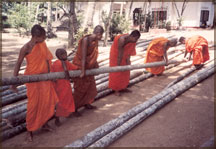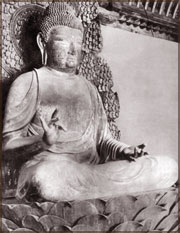|
dailynews |
|
|
|
|
|
OTHER LINKS |

|

|

|
|
|
|
'Natural science, in taking this concept as its starting-point and polishing it a little to remove irregularities, has no place for the individual and his sense experience (let alone mind-experience or imagination) for the material world of science is by definition utterly without a point of view (in relativity theory every point is a point of view, which comes to the same thing), it is uniformly and quite indifferently communal - it is essentially public. Consciousness, intention, perception, and feeling, not being public, are not a part of the universe of science.
Science is inherently incapable of understanding the nature of material change due to conscious action - which is concisely, reflexive exercise of preference of one available mode of behavior (or set of them) at the expense of others. (Quantum physics, in hoping to reinstate the 'observer' - even if only as a point of view -, is merely locking the stable door after the horse has been stolen). [Nanavira Thera, Notes on Dhamma, Vol. I, BCC, Sri Lanka, 2001, p. 99].
Name-and-matter [namarupa]
Consciousness is the presence of an object or idea [real or imaginary] in the five senses and mind. The phenomenon has two characteristics: inertia [patigha] and designation or name [adhivacana]. The inertia is 'rupa' or 'substance'. To be recognized as such, matter must be present for some time, however fleeting. Inertia can be understood also as the behaviour of matter.
The four modes of behaviour of matter [mahabhuta] are: earthy or persistent, resistant, or solid [patavi]; watery or cohesive [apo]; fiery or ripening, maturing [tejo]; airy or tense or distended, moving [vayo]. Space [akasa] is usually added but it has no standing of its own.
The designation or name of the phenomenon may also be seen as its appearance [vide, Russell, above]. This is the form adopted by the behaviour, as distinct from the behaviour itself.
It consists of the following, whether the presence of the phenomenon is (a) pleasant, unpleasant or neutral [vedana or feeling]; (b) recognition of its quality - shape, colour, smell, sound etc - or percepts [sanna or perception]; (c) significance or purpose [cetana or intention]; (d) engagement in experience [phassa or contact]; intentional direction of emphasis [manasikara or attention]. Contact specifies the kind of consciousness involved - eye, ear, nose, tongue, body, and mind-consciousness. Thus perception of fragrance specifies nose-consciousness. We cannot smell with our eyes. Experience is always selective. [There is more to be said but is outside the scope of this essay].
Behaviour
From the aforesaid, it will be noted that nama is the appearance of rupa. That is, what it looks like, its description; and conversely, rupa is the behaviour of nama. What is cognized is therefore namarupa. For example, the phenomenon of a fragrant red flower present in simultaneous eye and nose-consciousness will instantly evoke feeling.
Since the eye has a double faculty and can also ascertain touch sensitivity [that the flower is silky or smooth] the phenomenon is common to percepts of three senses. In other words, matter or rupa is independent of all consciousness. This is an extremely critical point to understand in Dhamma.
Cessation of matter
In the Kevaddhasutta [Digha I, 11] it is said that the question: 'Where do the mahabhuta finally cease?' is wrongly asked. It should be re-phrased: 'Where do they get no footing?' As noted above, matter is independent of all consciousness except for its presence in consciousness.
That is, matter cannot be said to exist. To say it exists, it must appear, even for a moment in time, whether real or imagined. Therefore, since it cannot be said to exist, it cannot cease. In other words, behaviour, in itself, does not involve consciousness, as perception does. In Dhamma terms, rupakkhanda is not phassapaccaya - conditioned by contact - as is sannakhanda.
A visual, auditory or any experience of the five senses and mind differ in consciousness but between them the difference is in matter (substance, inertia) and not in consciousness. What is the material difference between a blue thing and a red thing? They are simply different things or inertias. Thus difference in appearance (nama) is difference in consciousness (vinnana) or matter (rupa). Neither vinnana nor rupa, by itself, can appear or be manifest.
Consciousness by itself lacks substance. It is pure presence or existence without anything that is present. And matter by itself lacks presence or existence. It is pure substance or specification of which we cannot say 'it is' (i.e. it is present or absent) Appearance or manifestation must necessarily partake of an overlapping or imbrication of both vinnana and rupa (like tiles on a roof).
A simple superposition of two things each incapable of appearing would not produce appearance. Appearance, as it were, is sandwiched between vinnana and rupa: there must be rupa, and nama, and vinnana.
A general world would exist, where all experience is common to all individuals experiencing it, only if there is a general consciousness common to all. But this is a contradiction since consciousness and individuality are one. My consciousness and interpretation of a phenomenon in my consciousness does not necessarily evoke the same feelings and perception in another. Science cannot explain this change of matter or behavior with consciousness.
The behaviour [or matter] can get a footing in existence or in consciousness by being present in some form. With arising of consciousness, there is the arising of the mahabhuta.
As rupa in namarupa, the four mahabhuta get a borrowed existence as the behaviour of appearance, just as feeling, perception and intentions get a borrowed substance as the appearance of behavior.
Since namarupa is the necessary condition for consciousness [vinnana] - see the twelve-factored paticcasamuppada formulation -, with the cessation of namarupa, there is cessation of vinnana. The four mahabhuta now no longer get a footing in existence.
It is the end of existence. The consciousness of the arahat is anidassana, non-indicative. Phenomena do not present to a self. All subjectivity has ceased. He is freed from the nama-body. He experiences merely the elements of mahabhuta [and space] directly as objects. This is nibbana in the arahat. It is the aim of the Dhamma, here and now.
[PS: Note (a) the connectivity of Dhamma - opanayiko or leading onwards to full understanding or parinna (b) if matter is understood as in physics, nibbana would be impossible. Those interested to discuss further are invited to contact writer at 2866196 for an appointment.]
###############
Anapana Sati meditation (mindfulness of breathing)
MEDITATION: Considerable reference is made to the subject of Anapana Sati meditation. Both in the Maha Satipattana Sutta of the Digha Nikaya and the, Anapana Sati Sutta of the Majjhima Nikaya. The place, picture and description of Anapana Sati in both the Suttas is basically the same though not identical.
In the Anapana Sati Sutta of the Majjihama Nikaya (the new translation of Bhikkhu Nanamoli and Bhikkhu Bodhi first published in 1993, p. 643), it is stated as follows: "Bhikkhus, when mindfulness of breathing is developed and cultivated,it is of great fruit and great benefit ...
And how, bhikkhus, is mindfulness of breathing developed and cultivated, so that it is of great fruit and great benefit?
Here a bhikkhu, gone to the forest or to the root of a tree or to an empty hut, sits down; having folded his legs crosswise, set his body erect, and established mindfulness in front of him, ever mindful he breathes in, mindful he breathes out.
Breathing in long, he understands: 'I breathe in long', Or breathing out long he understands: 'I breathe out long'. Breathing in short, he understands: 'I breathe out long.' Breathing in short, he understands: 'I breathe in short; or breathing out short, he understands: 'I breathe out short'. He trains thus: "I shall breathe in experiencing" the whole body (of breath);' he trains thus: 'I shall breathe in tranquillizing the bodily formation'; he trains - thus: 'I shall breathe out tranquillizing the bodily formation."
Place
Thus, the recommended place for meditation on the breath is the forest, root of a tree or an empty hut. In the circumstances prevailing today, however,it would not be that convenient to strictly abide by these instructions.
Meditation masters are agreed that a silent place like a room where one could meditate without disturbance would be adequate, Anapana Sati means the mindfulness of the in and out breath. This is the first subject of meditation mentioned in Mahasatipattana Sutta among 40 subjects given for concentration.
Group and guided meditation is quite popular today for those keen to learn the technicalities of meditation. Though such a practice does not appear to have been mentioned in the teachings of the Buddha, if total silence is maintained in group meditation, there would be no hindrance to, the practice of this meditation, however large the gathering may be.
This was well demonstrated during the meditation sessions conducted by Ven. Ajahn Brahmavanso, the outstanding meditation master from Perth, Australia, when he conducted guided meditation to thousands at the BMICH, Dharmayatana in Maharagama, and Malabe where pin drop silence was maintained during actual meditation.
Next week: The correct posture for Anapana Sati meditation.
Courtesy: World of Buddhism.
###############
Preserve the murals of this ancient temple
MURALS: Wadduwa and Molligoda Maha Viharaya at Wadduwa is one of the ancient temples of Kalutara district.
The ancient temple was established by Ven. Welivita Pindapathika Asarana Sarana Sri Sadhalankara Sangharaja, the founder of Syamopali Maha Nikaya of Mahavatte Chapter.

It has been revealed in the historical documents the first residential bhikkhu of the temple was Ven. Wadduwe Dhamawansa Thera, a pupil of famous monk of Bentara Maha Nikaya residing at Gorakana in Panadura. Several eminent bhikkhus reside at the temple and contribute immensely to propagate Buddha dhamma since 1798.
The Buddha image and painted murals belonging to Kandyan period are gradually getting damaged by soot, burning camphor, candle light and incense. Ven. Bopitiye Dharmmisara the chief incumbent of Wadduwa Molligoda Maha Viharaya at Wadduwa said that the ancient paintings are gradually fading. The style of the paintings reveals the Sittara art tradition which should be preserved.
The most venerate Buddha image should be given a better look and this Buddha image is the cynosure of the surrounding temples. It is also gradually fading but it has an archaeological value. The Department of Archaeology should take necessary steps after conducting a comprehensive survey to preserve the inscriptions and the murals.
The chief incumbent of the temple said that the Dayakas of the temple
contribute for the progress of the temple but funds available in the
temple are insufficient to repaint the murals unless the Ministry of
Cultural Affairs take the initiative to preserve them.
 |
LABOUR: There is an acute shortage of labourers specially in urban areas to work in temples. In the past the ‘Dayakas’ of temples voluntarily attended to work of temples and cleaned the premises of the temples. Here, the young bhikkhus of a Pirivena at Wadduwa attempt to remove the arecanut trees to renovate the fence of the temple by themselves. The chief incumbent bhikkhu of the Pirivena said that the labour charges are high and the bhikkhus themselves attend to the work of the pirivena. K.A. Perera, Wadduwa special correspondent |





